Black Sea Shipyard: reconstruction of the plant and the transition to large-block assembly. TAKR "Baku"
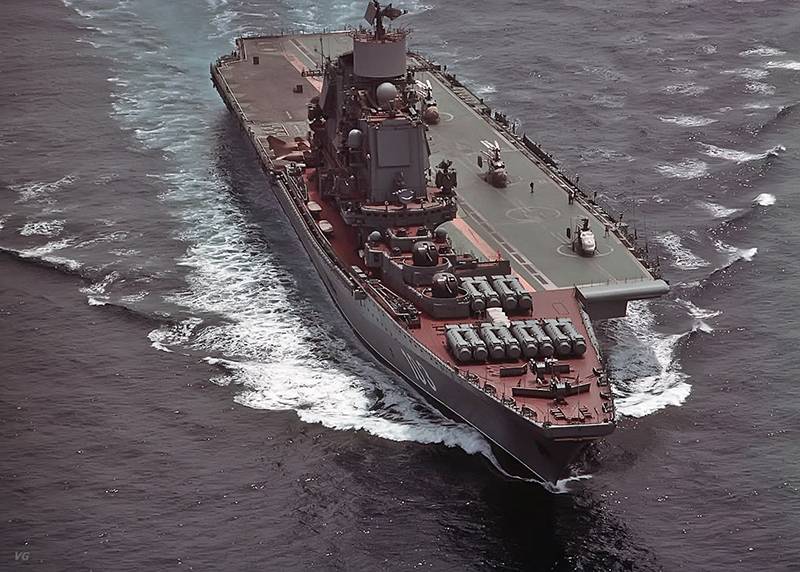
New look of the plant
Work on the reconstruction of the plant was parallel to the construction of heavy aircraft-carrying cruisers and civilian vessels. In the second half of the 70-s, the transformation of the production process took on a special scale. It was connected with the upcoming introduction of large-block hull assembly instead of traditional section-by-section, which already limited the technical capabilities of the plant.
The method of assembling a ship from large blocks was developed by the Nevsky Production and Design Bureau already 1973 in the framework of the unrealized project of an aircraft carrier with a nuclear power plant - 1160. It was supposed to be a ship with a displacement of 80 thousand tons with an air group consisting of 60 – 70 aircraft and helicopters. These aircraft carriers in the amount of three units were to be built in Nikolaev, tentatively in the middle of the 80s.
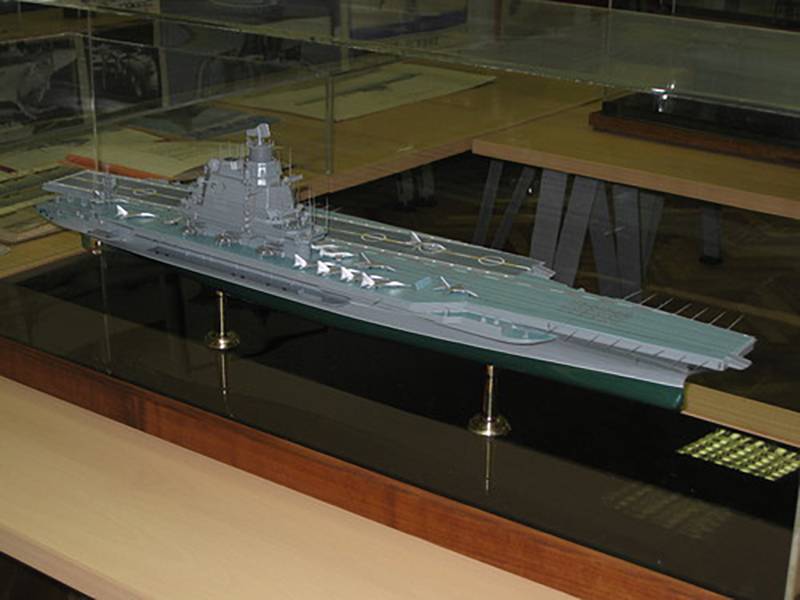
Subsequently, the project 1160 was redesigned to reduce the characteristics of the ship. Displacement was reduced to 70 th. Tons, reduced the number of air group. While maintaining the nuclear power plant, the aircraft carrier was to receive the P-700 Granit anti-ship complex. The project of the new ship was designated as 1153 "Eagle" - in contrast to the aircraft carriers of the project 1160 provided for the construction of only two "Eagles".
The construction of such a large ship required not only the reconstruction of the stocks, but also the modernization of the assembly process. The issue of equipping the Chernomorsky plant with two gantry cranes with a payload of more than 500 tons, discussed with the beginning of the construction of heavy aircraft-carrying cruisers, fully rose to the agenda.
On the initiative of the Ministry of Shipbuilding in the person of its head Boris Butoma, such equipment was planned to be purchased from Finland. History The purchase and installation of these large cranes deserves attention. It was supposed to buy two cranes for ChSZ, however, the leadership of the Nikolaev plant "Ocean", which specialized in building civilian vessels, including in dry dock, had a desire to "repel" one of the cranes for themselves. It was even ordered to work through this question. ChSZ representatives, first of all, the chief engineer, and later the director, Yury Ivanovich Makarov, managed to successfully extinguish the initiative of the enterprising “oceans”. After some calculations, it was easy to prove that the wall of the dry dock of the “Ocean” plant was simply not designed for the installation of a gantry crane, whose weight was estimated in total to 3500 tons.
At the beginning of 1977, the USSR Ministry of Foreign Trade signed a contract with the well-known Finnish company KONE to supply the customer with two gantry cranes with a lifting capacity of 900 tons each. The company was also obliged to install equipment for installation and three portal cranes of smaller capacity, which were also planned to be installed on the stocks number "0". The cost of the contract was impressive at the then price level: over 20 million dollars.
In order to successfully install the purchased equipment, the plant had to carry out a huge amount of work. In addition, another challenge was to ensure the unloading of large multi-ton structures, which were delivered around the whole of Europe by special transport pontoons. In the end, we decided to build two 70-meter breakwaters with crane runways on both sides of the stocks. Thus, an artificial harbor with the size of 150 × 70 meters should have been formed - with a promising opportunity to receive large cargoes delivered by water to the crane space.
Work on the preparation of the stocks led Odessa company Chernomorgidrostroy. A group of highly qualified engineers, specialists who had previously been involved in the reconstruction of the White Sea-Baltic Canal, headed by Ivan Mikhailovich Nagorny, arrived in Nikolaev. Thirty-meter piles were driven under the crane runways. The work was complicated by the difficult rock profile with depth variations of up to 15 meters at sites in 10 – 20 meters. The sappers of the 92-th Guards Red Banner Krivoy Rog Infantry Division deployed in Nikolaev were involved in the process. They were the ones who, by directed explosions, “cut off” the piles that were driven into the ground to the desired level.
The works went on schedule, and already in the autumn of 1978, the Black Sea Shipyard was ready to receive the first crane. Finns responsibly reacted to the order of the Soviet side. They regularly informed the factory about the progress of work, monthly sending schedules and photographs. The Ministry of Shipbuilding kept the construction at the Black Sea Plant under control - the concern was justified by the fact that no one in the Soviet Union had any experience in assembling such huge cranes: for example, it was necessary to lift a cargo beam weighing 2226 tons to 110 meters.
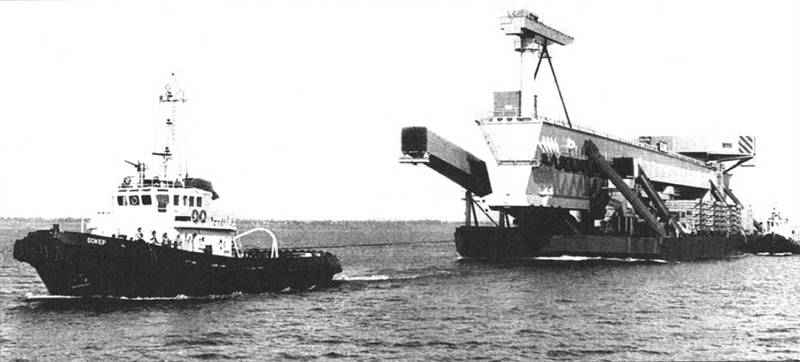
The installation of such complex equipment was to be carried out by specialists of the Ministry of the Ukrainian SSR of assembly and special construction work, which was led by George Rubenovich Bagratuni. It was on his project by the method of growing from below that the construction of the 300-meter tower of the Kiev television center was carried out in due time.
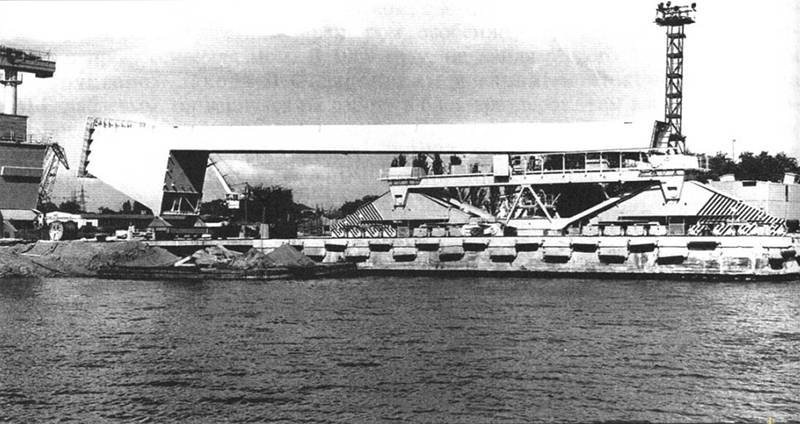
In the autumn of 1978, all the preparatory work was generally completed - the plant was ready to accept the latest equipment. In the summer of 1979, the first crane arrived on a special towed transport barge. In September, it was unloaded on shore, and installation began. Soon the second crane also arrived - it took four transport pontoons to transport the entire mass of the ordered equipment. Works on installation of cranes were conducted around the clock. In January, the first crane was lifted 1980, and work began on the second.
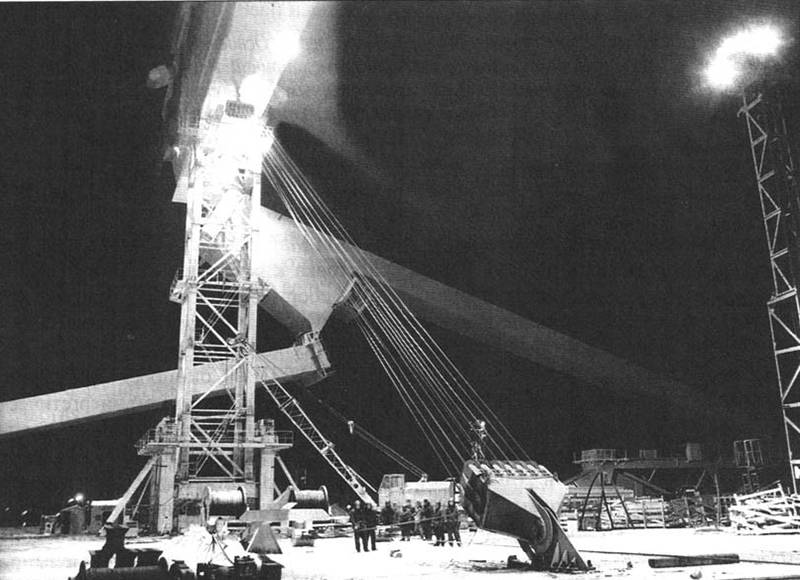
In the course of such a difficult process, which was also carried out for the first time, the consultations and advice of the representatives of the manufacturer, KONE itself, were not at all superfluous. The curiosity of the situation was that Nikolaev, one of the largest shipbuilding centers in the USSR, was closed to foreigners. Arriving Finns were placed in a remote area of the city, from where, however, the installation of huge structures could be seen with the naked eye. From here, directly from the hotel, the guests carried out their consulting assistance by telephone. Subsequently, this story was overgrown with various anecdotal rumors and speculation - the factory legends later sent “hot Finnish guys” even to Kherson!
In December 1980, the entire complex was successfully commissioned.
Continuation of construction
While the Black Sea Shipyard was building almost “cyclopean” structures of gantry cranes, which gave the company not only unique opportunities, but also a unique look, the construction of heavy aircraft-carrying cruisers continued.
In the Soviet military leadership and in the 70s. there was no consensus on the construction, use and role of aircraft carriers in the domestic navy. More or less clearly loomed two parties with different opinions on this issue. The first, inspired by Fleet Commander Admiral Sergey Georgievich Gorshkov and Defense Minister Marshal Andrei Antonovich Grechko, advocated the construction of full-fledged aircraft carriers equipped with catapults and horizontal take-off and landing aircraft. They were actively helped by the Minister of Shipbuilding Boris Yevstafyevich Butoma.
Opponents, the main ones of which were the secretary of the Central Committee of the CPSU in the defense industries Dmitry Fedorovich Ustinov and the Chief of the General Staff Marshal Nikolai Ogarkov considered such ships too expensive for the defense budget of the country, which was already heavily loaded. According to opponents of the development of aircraft carriers, they were problematic to fit into the Soviet military doctrine, where the fleet initially prepared for a global nuclear war. Supporters of Ustinov and Ogarkov expressed that aircraft carriers were primarily a tool for local wars in remote territories, and the Soviet Navy was not supposed to be used in such conflicts.
After lengthy disputes, a compromise was reached: build the third ship of the 1143 project, the Krechet cipher (future Novorossiysk), and then proceed to build the aircraft carriers of the 1153 Orel project with a nuclear power plant. However, in 1976, the aircraft carrier support group suffered significant losses - Marshal Grechko and Minister of Shipbuilding Boutom died. Ustinov stood at the head of the defense department, who was cool towards building such ships.
The result was the cessation of work on the 1153 "Eagle" project and the decision to build the fourth heavy aircraft carrier cruiser of the 1143 "Krechet" project. True, unlike the previous three, this ship was supposed to have much more advanced electronic weapons. The air group of the ship was supposed to consist of the promising Yak-41 aircraft, by all indicators superior to the former Yak-38. The redesigned project, which was handled by the Neva Design Bureau, received an index of 1143.4 (later simply 11434).
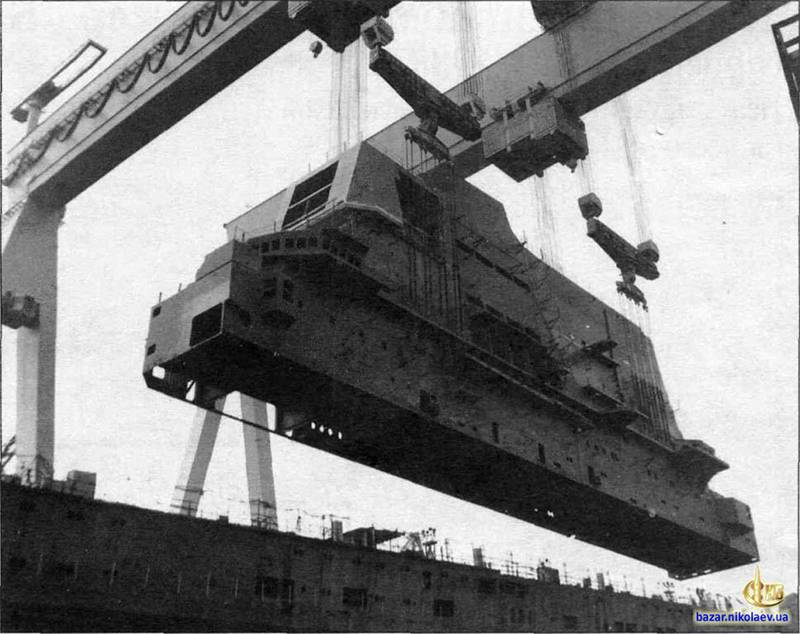
The ship was laid on the stocks number "0" 26 December 1978. The fourth heavy aircraft carrying cruiser was named "Baku". The construction process was greatly improved: the plant was now equipped with two 900-ton cranes and a near-wall slab on which it was possible to manufacture large-sized blocks weighing up to 1500 tons each. At the beginning of 1982, for the first time in the history of domestic shipbuilding, two blocks were formed on the near-wall slab and installed on the slipway with the help of new cranes: a large-sized aft block weighing 580 tons and a superstructure block weighing 830 tons.
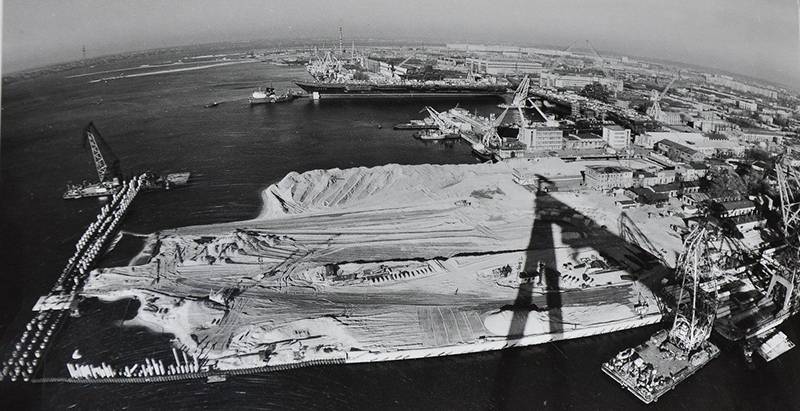
In parallel with the construction of the 104 order (as it was designated in the “Baku” factory documentation), large-scale repair work was completed on the North Embankment of the Great Bucket, where ships had to be completed afloat. 31 March 1982, the heavy aircraft-carrying cruiser "Baku" was launched. The launching weight of the ship reached 19 thousand tons. In contrast to the slipway period, the construction afloat was delayed. First of all, it was connected with the usual changes in the project and the numerous alterations connected with them.
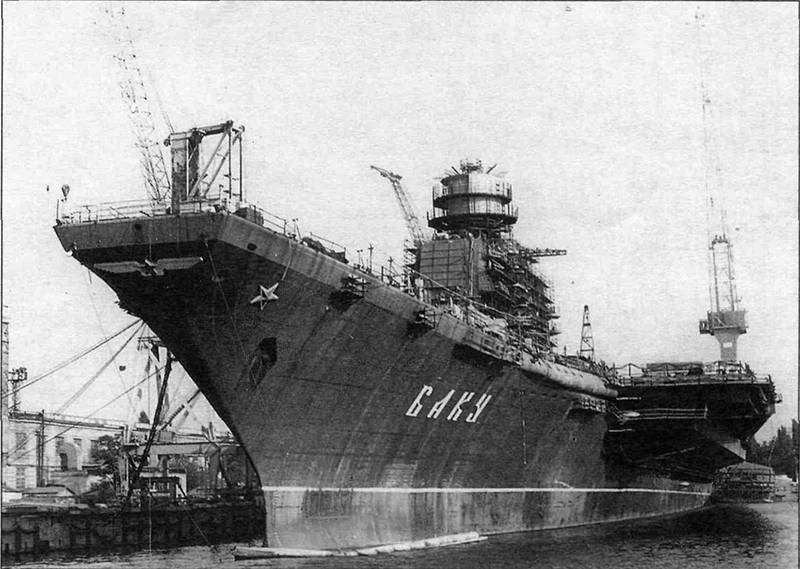
"Baku" was significantly different from the three previous ships. The number of launchers of the P-500 anti-ship complex Granit was increased from 4 dual launch launchers to 6, which gave 12 missiles in a volley against the previous 8. For the first time on the "Baku", in contrast to previous aircraft-carrying cruisers, provided for constructive protection. She defended the walls of the hangar and rocket cellars. Its total mass reached 1700 tons. According to calculations, “Baku” could theoretically withstand the hit of 10 – 12 missiles “Garpun” or 6 – 8 of anti-ship cruise missiles “Tomahawk”. Near-zone air defense was provided by the newest Dagger anti-aircraft missile systems.
The technology of applying the radio-absorbing coating “LAC” was also tested at “Baku” - it was created by applying separate layers of special components to the outer surfaces of the 100 – 110 superstructure according to a complex technological scheme. The total area covered by LAC reached 2400 square meters. The operation was performed during the summer periods of 1985 – 1986.
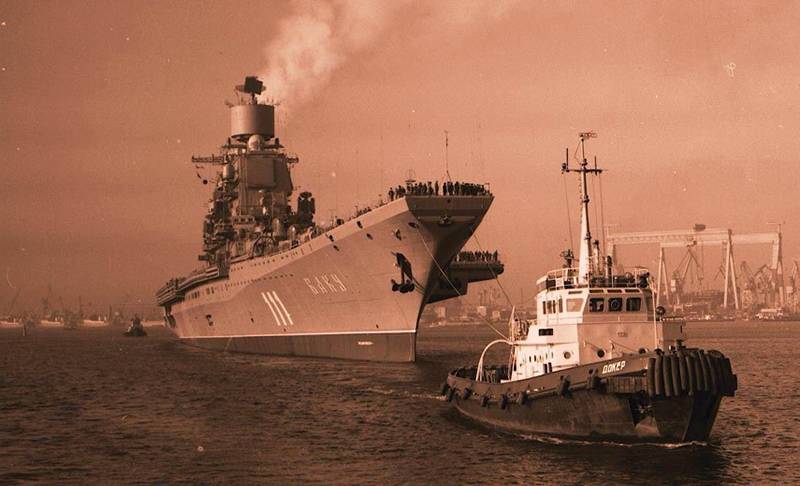
Alterations, as well as disruptions in the supply of components and equipment, led to the “Baku” launching mooring trials of 6 on June 1986 of the city, that is, 7 years and 5 months after laying. 4 December 1986, the cruiser went to Sevastopol. There, he went docking for cleaning and painting the bottom, and in January 1987-go out on sea trials, where he developed the speed of 30,5 knots. In April, state trials began. During them, a number of flaws were fixed in the latest anti-aircraft missile and radio electronic equipment, including problems with the Dagger complex. However, the acceptance certificate was signed on 11 on December 1987 of the year. All defects found during the tests were planned to be eliminated already during the operation of the cruiser. In total, 8 years, 11 months and 5 days passed from the moment of laying up to the fleet.
In April, 1988 g. “Baku” was incorporated into the permanent readiness forces and began preparations for the transition to the North. 7 June cruiser left Sevastopol, starting his march. Already during his stay in the Mediterranean Sea, with the help of satellite targeting systems and data coming from the Central Fleet Command Center, the cruiser monitored the US nuclear aircraft carrier Dwight Eisenhower, being in 7-minute readiness for launching the Granites. Having made calls to the Syrian ports of Latakia and Tartus and having bypassed Europe, 17 December 1988 “Baku” arrived in Severomorsk.
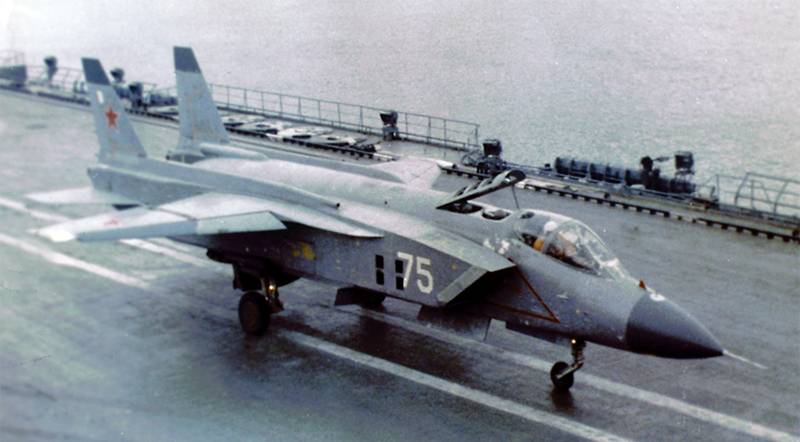
During 1989 – 1990 the cruiser conducted numerous shooting and exercises, including with the landing of landing troops. October 4 1990 was renamed the Admiral of the Fleet of the Soviet Union Gorsh. In 1991, the heavy aircraft cruiser service continued, albeit with less intensity. September 21 on its deck for the first time landed the latest fighter vertical takeoff and landing of the Yak-141. October 5 during testing the second prototype of the aircraft as a result of a hard landing burned down - the pilot ejected. This was a pretext for closing the entire work program for this prospective aircraft.
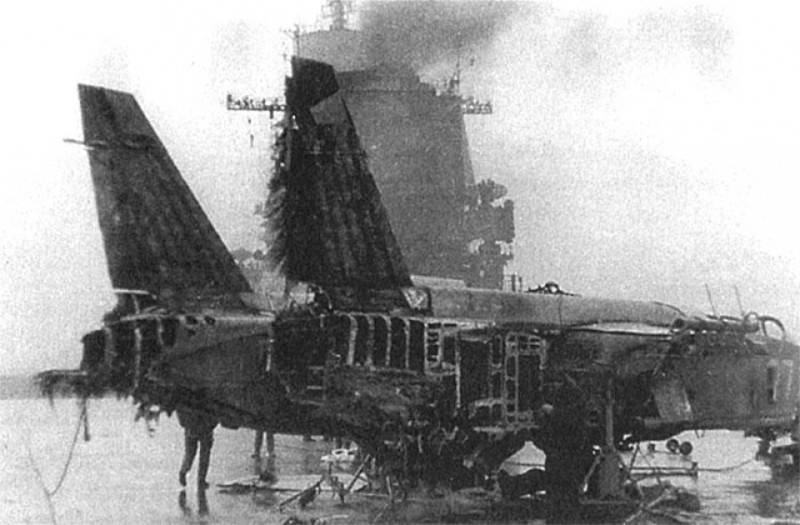
In 1992, the “Gorshkov” was sent for repairs, which, due to lack of funds, was greatly delayed. In 1995, it was placed in Rosta (Kola Bay) for long-term storage. Perhaps, Gorshkov would have waited for the unenviable fate of being scrapped for scrap, however, in principle, India was interested in this new ship in order to acquire and restructure into a “classic” aircraft carrier. The cruiser was transferred to the Sevmash enterprise, the final signing of the contract with the Indian side took place in the autumn of 2000. The Gorshkov had to undergo a radical alteration: almost all of its weapons were dismantled from it.
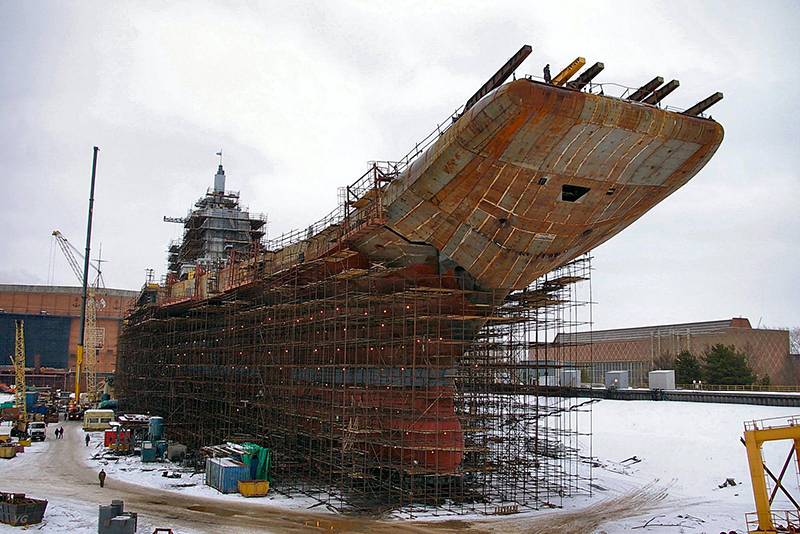
The ship received a solid flight deck with a springboard and aerofinisher. The internal premises also underwent major redevelopment. Work on the ship began in the year 2004. Initially, the transfer of India aircraft carrier, known as "Vikramaditya", was to be held in 2008, however, due to the enormous amount of work and crisis in a number of defense industries that fully experienced the consequences of the collapse of the Soviet Union, they were postponed several times. India received a completely redesigned and modernized ship in July 2013 of the year - due to the accident of the boilers in the running test in the previous 2012, this procedure was delayed for another year. The air group of the cruiser consists of the MiG-29K, MiG-29KUB deck fighters and Ka-28 or Sea King helicopters totaling from 30 to 36 units. In November, 2013, the aircraft carrier went to the place of its new service.
So, of the four first-generation heavy aircraft carrying cruisers built at the Black Sea Shipbuilding Plant in Nikolaev, there are three left in the metal: "Kiev" and "Minsk" are in China as museums and entertainment centers, and the fourth continues its service almost for its intended purpose, however under the flag of a foreign state.
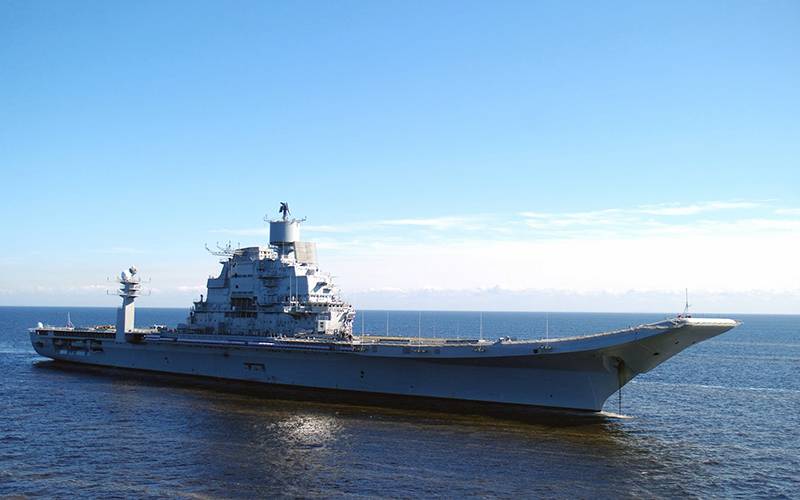
At the beginning of the 1980's The Black Sea Plant began construction of aircraft carriers of a completely new project.
- Denis Brig
- CSY: the development of heavy aircraft-carrying cruisers. "Minsk" and "Novorossiysk"
CSY: TAKR "Kiev"
CSY: research vessel "Akademik Sergey Korolev"
CSY: whalers and anti-submarine cruisers
CSY: years of occupation and recovery after the war
CSY: submarines, cruisers, battleships and icebreakers
CSY: destroyers leaders and submarines
Information